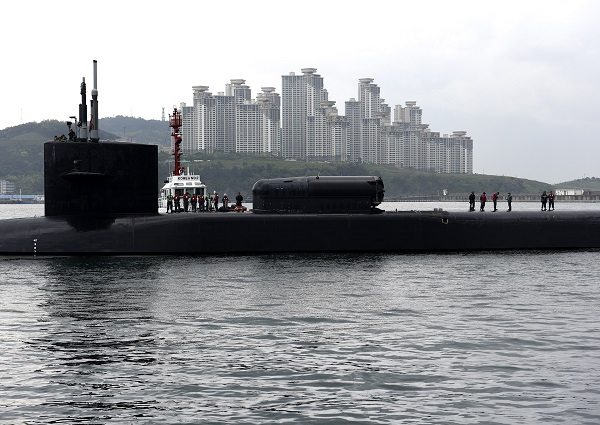The United States military staged a massive show of force against North Korea by deploying its strategic assets to the Korean Peninsula on Tuesday, as North Korea marked a major holiday amid mounting multilateral pressure on the regime’s nuclear ambition.
The nuclear-powered USS Michigan made a call at the Port of Busan in time for the 85th anniversary of the founding of the North Korean People‘s Army. The USS Carl Vinson aircraft carrier strike group is also heading toward the East Sea to join a maritime drill with South Korea’s Navy in a few days.
 |
The nuclear-powered USS Michigan arrives in Busan on Tuesday as a show of force against North Korea’s missile and nuclear program. (Yonhap) |
Despite speculation that Pyongyang would celebrate its holiday with a sixth nuclear test, there have been no “unusual activities” inside the regime, said South Korea’s Joint Chiefs of Staff. Instead, the North held a “large-scale” long-range artillery drill in the eastern port city of Wonsan, the JCS added.
The move came amid increasing pressure from the US and its allies on North Korea’s nuclear and missile programs. President Donald Trump urged the United Nations to impose “stronger sanctions” if Pyongyang continued to defy the UN’s ban on nuclear and missile tests.
“This is a real threat to the world,” Trump said during his meeting with UN Security Council ambassadors at the White House, referring to North Korea’s nuclear and ballistic missile programs. “North Korea is a big world problem. And it’s a problem we have to finally solve.”
In an interview with CBS, Nikki Haley, the US Ambassador to the United Nations, suggested Washington might consider military retaliation against Pyongyang’s provocations, urging the North “not to give us a reason to fight.”
South Korea, the US and Japan’s special envoys to six-party talks met in Tokyo on Tuesday to discuss measures to address North Korea’s nuclear program. They agreed to impose “unbearable punitive measures” on Pyongyang’s military provocation.
While calling for “restraint” in dealing with North Korea, China sent its top nuclear envoy Wu Dawei to Japan to exchanges views on Pyongyang’s nuclear program. The Chinese state-run media, for its part, delivered a stern warning against the North, saying any nuclear tests would deal a serious blow to the regime.
On Saturday, China’s Global Times said China would not engage militarily if the US conducted a surgical strike on North Korea’s nuclear facilities. The comments were widely seen as a shift in tone on Beijing’s dealings with North Korea.
The warnings from the Chinese media “represent a changed mood in China that North Korea should be viewed as a liability, not a strategic asset,” said Seoul’s Foreign Ministry spokesperson Cho June-hyuck at a news briefing Tuesday.
In an editorial from its state-run Rodong Shinmun, North Korea continued to reiterate its bellicose rhetoric against the US, saying they have all the “commitment and capability” to respond to any military confrontation.
Meanwhile, South Korea has conducted a large-scale live-fire drill from April 13-26 at a military facility in Pocheon, Gyeonggi Province. The drill has involved Army, Navy and Air Force. The US Army has also joined the exercise.
Later in the day, the South Korea Navy also conducted a joint live-fire exercise with the US in the West Sea. It involved the Navy’s 4,400-ton destroyer Wanggeon and the USS Wayne E. Meyer, the US Navy’s Arleigh Burke-class guided missile destroyer.
By Yeo Jun-suk (
jasonyeo@heraldcorp.com)






![[Herald Interview] 'Trump will use tariffs as first line of defense for American manufacturing'](http://res.heraldm.com/phpwas/restmb_idxmake.php?idx=644&simg=/content/image/2024/11/26/20241126050017_0.jpg)
![[Health and care] Getting cancer young: Why cancer isn’t just an older person’s battle](http://res.heraldm.com/phpwas/restmb_idxmake.php?idx=644&simg=/content/image/2024/11/26/20241126050043_0.jpg)
